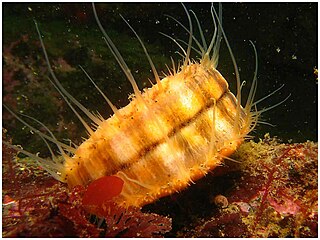Pseudoalteromonas is a genus of marine bacteria. In 1995, Gauthier et al proposed Pseudoalteromonas as a new genus to be split from Alteromonas. The Pseudoalteromonas species that were described before 1995 were originally part of the genus Alteromonas, and were reassigned to Pseudoalteromonas based on their rRNA-DNA analysis.

Trichoplax adhaerens is one of the four named species in the phylum Placozoa. The others are Hoilungia hongkongensis, Polyplacotoma mediterranea and Cladtertia collaboinventa. Placozoa is a basal group of multicellular animals, possible relatives of Cnidaria. Trichoplax are very flat organisms commonly less than 4 mm in diameter, lacking any organs or internal structures. They have two cellular layers: the top epitheloid layer is made of ciliated "cover cells" flattened toward the outside of the organism, and the bottom layer is made up of cylinder cells that possess cilia used in locomotion, and gland cells that lack cilia. Between these layers is the fibre syncytium, a liquid-filled cavity strutted open by star-like fibres.

Peltodoris nobilis, commonly called the sea lemon, false sea lemon, or the noble dorid, is a species of colorful sea slug, a dorid nudibranch, a shell-less marine gastropod mollusk in the family Discodorididae.

Chlamys hastata, the spear scallop, spiny scallop or swimming scallop, is a species of bivalve mollusc in the family Pectinidae found on the west coast of North America from the Gulf of Alaska to San Diego, California. A limited number of these scallops are harvested by divers or by narrow trawls off the west coast of Canada.
Mycale grandis, the orange keyhole sponge, is a species of marine demosponge in the family Mycalidae. Mycale is a large genus and this species is placed in the subgenus Mycale making its full name, Mycale (Mycale) grandis.
Pseudoalteromonas distincta is a marine bacterium.
Pseudoalteromonas elyakovii is a marine bacterium.
Pseudoalteromonas flavipulchra is a rod-shaped gram-negative marine bacterium.
Pseudoalteromonas maricaloris is a marine bacterium which was isolated from the sponge Fascaplysinopsis reticulata in the Coral Sea.
Pseudoalteromonas paragorgicola is a marine bacterium isolated from a sponge in the Pacific Ocean.
Algicola sagamiensis is a marine bacterium isolated from sea water in Sagami Bay. It was originally named Pseudoalteromonas sagamiensis but was reclassified in 2007 into the genus Algicola.
Pseudoalteromonas donghaensis is a marine bacterium which was originally isolated from seawater near South Korea.
Pseudoalteromonas lipolytica is a marine bacterium which was isolated from the Yangtze River.

Mycale laevis, the orange icing sponge or orange undercoat sponge, is a species of marine demosponge in the family Mycalidae. Mycale is a large genus and this species is placed in the subgenus Mycale making its full name, Mycale (Mycale) laevis. This sponge is found in the Caribbean Sea and the Gulf of Mexico and usually grows in association with one of a small number of species of coral.
Streptomyces spongiae is a bacterium species from the genus of Streptomyces which has been isolated from the marine sponge Haliclona in Tateyama in Chiba in Japan.
Mycale adhaerens, the purple scallop sponge, is a species of marine demosponge in the family Mycalidae. Mycale is a large genus and this species is placed in the subgenus Aegogropila making its full name, Mycale (Aegogropila) adhaerens. It grows symbiotically on the valves of scallop shells and is native to the west coast of North America.
Saccharopolyspora spongiae is a bacterium from the genus Saccharopolyspora which has been isolated from the sponge Scopalina ruetzleri.
Mangrovimonas spongiae is a Gram-negative, rod-shaped and motile bacterium from the genus of Mangrovimonas which has been isolated from a marine sponge from the Yangpu Bay in China.
Zhouia spongiae is a Gram-negative, rod-shaped and non-motile bacterium from the genus of Zhouia which has been isolated from a sponge from the Yangpu Bay on Hainan.
Nonlabens spongiae is a Gram-negative, strictly aerobic, rod-shaped and motile bacterium from the genus of Nonlabens which has been isolated from a marine sponge from the Bahamas.



